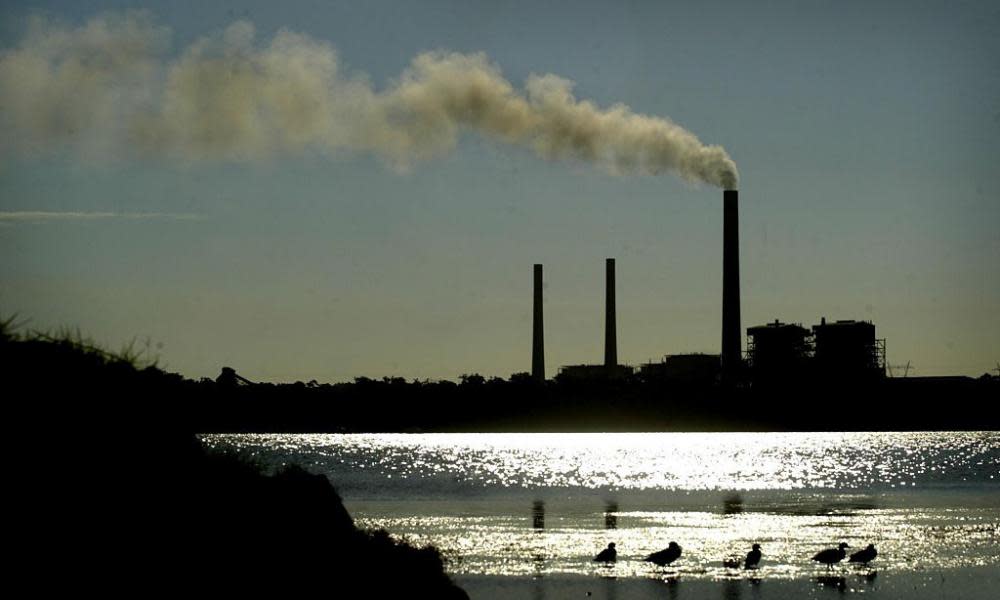Emissions reduction fund could be used to upgrade 40-year-old coal-fired power plant

The emissions reduction fund, which is at the heart of the Morrison government’s climate change policy, could be used to help pay for an upgrade at a 40-year-old coal-fired power plant after its owners successfully applied to register under the scheme.
In a step that underscores the political divide over emissions policy, Vales Point power station in New South Wales was registered in August for a proposal to improve some of its turbines. It is the first stage in it being allowed to bid against land owners and other businesses for climate funding.
The Coalition has indicated it is considering tipping more into the fund, which started with $2.55bn but is now near empty, before this year’s election. The fund has so far failed to curb national emissions, which have increased each year since the government abolished a carbon pricing scheme in 2014.
The Australian Conservation Foundation said it was shocking that taxpayers’ money meant to combat climate change could go to coal power plants.
“No government should be propping up ailing coal generators with public funds, especially as any major capital works would help extend the life of a plant that should be retired,” said ACF chief executive Kelly O’Shanassy.
“Vales Point getting even this far in the process is a clear sign the emissions reduction fund needs structural reform before any new injection of cash is considered.”
Owners say plant is eligible for climate funding
Sunset Power International bought Vales Point from the NSW government for $1m in 2015. Two years later it was re-valued at $730m and last year it reported a net profit of $113m.
Its part-owner, coal power advocate and former National Party candidate Trevor St Baker, has flagged extending its operation beyond its expected closure date of 2029 to 2049. Managing director Greg Everett said prolonging the plant’s life was a $400m decision and had nothing to do with its pitch into the emissions reduction fund.
Everett said that project – replacing components on two units commissioned in 1978 – would cost $14.2m and cut emissions by 900,000 tonnes over the decade to 2029. Based on its current emissions of 6.9m tonnes a year, this is a 1.3% cut below what it would be expected to emit.
He said the company’s initial bid would be for about $600,000 to pay for an emissions reduction of 50,000 tonnes.
But the proposal has stalled due to a disagreement with the Clean Energy Regulator, which administers the fund, over whether the project needs to push the plant’s emissions intensity – how much it emits per unit of electricity generated – below the grid average. This shift is necessary for it to bid for funding.
Everett said that condition should not apply as the project would upgrade only a small part of the plant. He said the fund’s guidelines included coal power as being able to receive carbon credits. The methodology that covers the plant is being reviewed by an independent emissions reduction assurance committee.
Everett rejected suggestions Vales Point should not be eligible for climate funding. He said it played an important role in the grid alongside variable renewable energy.
“They try to make out like it’s either/or when in reality a lot of these technologies work together to ensure a secure system,” he said. “The benefit to the community is this is low-cost emissions reduction.”
The push for climate funding coincides with St Baker asking the government to underwrite a $6bn plan with a Chinese partner to build three new coal-fired plants in Victoria and NSW, including a new generator next to Vales Point.
Reviving the emissions reduction fund
The centrepiece of Tony Abbott’s “direct action” climate policy, the fund has been gradually whittled down and was not expected to be revived until the government abandoned its national energy guarantee policy and it became clear that voter concern about climate change was likely to play a significant role at this election.
The cash is distributed through reverse auctions, with the cheapest cuts proposed winning contracts and the right to generate carbon credits. The government buys credits back once the cuts are verified. To date, the fund has paid out $476m, committed another $1.8bn and has $226m left unspent.
Last year a Guardian Australia investigation found it was often difficult to determine if the fund was offering value for money.
Some projects were clearly not. The independent assurance committee found landfill sites that capture and burn leaking methane to generate electricity, for instance, would have existed without the fund’s support.
Asked whether the fund should be used for coal plants, a spokesman for environment minister Melissa Price said it was technology neutral and its methods required emissions cuts to be genuine. For Vales Point, upgrades to essential components must lower emissions intensity below the grid average to receive carbon credits.
Opposition climate spokesman Mark Butler said the fund was ineffective. “As Malcolm Turnbull famously said at the time, it is a fig-leaf to cover a determination to do nothing,” he said.
Greens climate spokesman Adam Bandt said it should be abolished with the money redirected to storage, renewable energy zones and a “proper carbon farming initiative”.

 Yahoo News
Yahoo News 
